Decorating a cake is more than just adding a topping or two – it’s an art form that can elevate any baked creation from ordinary to extraordinary. The decoration for cakes plays a crucial role in not only enhancing the visual appeal but also adding flavor and texture to the overall taste experience. Whether it’s a simple birthday cake or an elaborate wedding cake, the way it is adorned can make all the difference.
When it comes to cake decoration, there are various types of techniques and decorative elements that can be used. From fondant and buttercream to royal icing and edible images, the options are endless. Each type of decoration offers its own unique qualities and requires different skills and tools to achieve the desired look.
In this article, we will delve into the world of cake decoration, exploring the different types of decorations, the tools and equipment needed, step-by-step guides for achieving professional-looking results, current trends in cake decoration, tips for success, and the importance of presentation. So whether you’re a novice baker looking to improve your skills or a seasoned pro wanting to stay on top of the latest trends, this comprehensive guide has something for everyone.
Types of Cake Decorations
When it comes to cake decoration, there are numerous options to choose from. Each type of decoration has its own unique characteristics and techniques, allowing for endless creativity and customization. Whether you prefer a smooth fondant finish, the richness of buttercream, the delicate beauty of royal icing, or the natural elegance of fresh flowers and edible images, there is a decoration method that suits every taste and occasion.
Fondant
Fondant is a popular choice for cake decoration due to its versatility and smooth finish. Made from sugar, water, gelatin, and glycerin, fondant can be rolled out to cover cakes and create intricate designs like ruffles, bows, and 3D decorations. It allows for a flawless canvas for creativity as it can be easily tinted with food coloring to achieve any desired color.
Buttercream
Buttercream is known for its rich flavor and creamy texture, making it a beloved choice for many cake decorators. This type of frosting can be used to create various textures such as smooth finishes or decorative swirls using different piping tips. Buttercream decorations are also ideal for adding depth and dimension to cake designs.
Royal Icing
Royal icing is made from egg whites or meringue powder mixed with powdered sugar. It dries hard and is often used for creating intricate piped details such as lace work, flowers, and delicate borders. Royal icing is also perfect for creating edible decorations in advance as they dry solid and can easily be applied onto cakes at a later time.
Fresh Flowers and Edible Images
Fresh flowers have long been used as cake decorations due to their natural beauty. They add an elegant touch to cakes and come in a variety of colors and styles. Edible images are created using food-safe ink on edible paper sheets that can be customized with any design or photograph desired to complement the theme of the event.
Incorporating these various types of cake decorations allows for endless possibilities in creating stunning confections that not only taste delicious but also serve as works of art that leave lasting impressions on any celebration.
Tools and Equipment Needed for Cake Decoration
When it comes to cake decoration, having the right tools and equipment is crucial to achieving professional-looking results. Whether you are working with fondant, buttercream, or royal icing, the following tools are essential for any cake decorator.
Piping Bags and Tips
Piping bags and tips are fundamental for creating intricate designs and patterns on cakes. Piping bags come in various sizes and materials, such as disposable plastic or reusable fabric, while piping tips come in different shapes and sizes for creating different effects. For beginners, a basic set of piping tips and a couple of sturdy piping bags are sufficient to get started.
Offset Spatula
An offset spatula is a must-have tool for spreading frosting evenly and smoothly on the surface of the cake. This handy tool also helps in lifting delicate decorations and transferring them onto the cake without damaging them. Look for an offset spatula with a comfortable handle and a flexible blade for maximum control.
Turntable
A turntable is an indispensable tool for cake decorators as it allows for easy 360-degree access to the cake while decorating. It makes frosting the sides of the cake, creating smooth finishes, and adding intricate details much more manageable. Invest in a sturdy turntable that can support the weight of your cakes without wobbling.
Step-by-Step Guide to Cake Decoration
Cake decoration is an essential part of creating a visually appealing and mouth-watering dessert. Whether you are a professional baker or someone who loves to bake at home, knowing how to decorate a cake can take your baking skills to the next level. In this section, we will provide a step-by-step guide to cake decoration, covering techniques such as crumb coating, achieving a smooth finish, piping techniques, and fondant application.
To achieve a professional-looking cake decoration, it’s important to start with a crumb coat. This thin layer of icing seals the crumbs from the cake and provides a smooth base for the final layer of frosting or fondant.
To apply a crumb coat, use an offset spatula to spread a thin layer of buttercream or ganache over the entire cake. Once the crumb coat is applied, chill the cake in the refrigerator for about 15 minutes to allow it to set before applying the final layer of frosting.
Next, focus on achieving a smooth finish for your cake. Using an offset spatula and a turntable can help you evenly distribute and smooth out the frosting around the sides and top of the cake. It’s important to take your time with this step to ensure that the surface is free from any imperfections or air bubbles.
When it comes to piping techniques, there are various designs and patterns that can be created using different piping tips and bags. From simple borders and swirls to intricate flowers and intricate patterns, mastering different piping techniques can add dimension and creativity to your cake decoration.
Lastly, fondant application offers another way to decorate cakes by allowing for sculpting, shaping, and intricate designs. With proper practice and technique, fondant can be used to create stunning decorations that resemble works of art on cakes.
Overall, mastering these step-by-step cake decoration techniques-crumb coating, achieving a smooth finish, piping designs with precision, and fondant application-can elevate your baking game while adding beauty and creativity to your desserts.
Cake Decoration Trends
When it comes to cake decoration, trends are constantly evolving. One of the most popular trends in recent years is the drip cake. This style involves drips made from ganache or icing that cascade down the sides of the cake, creating a modern and artistic look.
Geode cakes have also become a sensation, with stunning edible crystal formations made from sugar and rock candy. These cakes are true showstoppers and are often used for special occasions such as weddings or milestone birthdays.
Meanwhile, naked cakes have gained popularity for their rustic and minimalist appearance. These cakes feature thinly iced layers that allow the cake to peek through, giving a simple yet elegant aesthetic. Finally, floral designs continue to be a timeless trend in cake decoration. Whether using fresh flowers or intricate sugar flowers, these designs add a touch of natural beauty to any cake.
In the world of cake decorating, staying current with trends is essential for those looking to offer unique and attractive creations to their clients. Whether it’s mastering the art of drip cakes or perfecting the delicate details of floral designs, keeping up with these trends can help decorators set their work apart in a competitive market.
| Cake Decoration Trend | Description |
|---|---|
| Drip Cakes | Cascade of ganache or icing down the sides of the cake for a modern look |
| Geode Cakes | Edible crystal formations made from sugar and rock candy that create stunning showstopper cakes |
| Naked Cakes | Rustic and minimalist appearance with thinly iced layers allowing the cake to peek through for a simple yet elegant aesthetic. |
| Floral Designs | Incorporates either fresh flowers or intricate sugar flowers to add natural beauty to any cake. |
Tips for Successful Cake Decoration
Successful cake decoration requires attention to detail and the use of proper techniques. One of the key factors in achieving a beautifully decorated cake is ensuring the proper consistency of icing. Whether using buttercream, royal icing, or fondant, the right consistency is essential for smooth application and clean lines. Buttercream should be smooth and fluffy, while royal icing should hold its shape when piped. Fondant should be pliable but not sticky.
Color mixing is another important aspect of cake decoration. Achieving the perfect shade to match your design or theme can make a significant difference in the overall look of the cake. It’s essential to use gel-based food coloring for vibrant and consistent hues.
Start with a small amount of color and gradually add more until you achieve the desired shade. Remember that colors will deepen over time, so it’s best to allow some time for the color to develop before making any adjustments.
Precision in design is crucial for creating intricate and visually appealing decorations on cakes. Whether using piping techniques, sculpting fondant, or adding edible embellishments, attention to detail is imperative. Practice piping on parchment paper before decorating your cake to ensure steady hands and even pressure. When working with fondant, use sharp tools for clean cuts and textured molds for dimension.
| Key Tips | Description |
|---|---|
| Proper Consistency of Icing | Essential for smooth application and clean lines. |
| Color Mixing | Achieving the perfect shade using gel-based food coloring. |
| Precision in Design | Attention to detail is crucial for creating visually appealing decorations. |
Importance of Presentation in Cake Decoration
When it comes to cake decoration, the presentation plays a crucial role in making a lasting impression. The way a cake is displayed can elevate the overall appeal and create a sense of grandeur. There are several elements that contribute to the presentation of a decorated cake, including tiers, cake stands, and cake toppers.
Tiers are an essential aspect of cake presentation, especially for special occasions such as weddings and milestone birthdays. The use of multiple tiers adds height and elegance to the cake, making it a focal point of the event. Whether it’s a traditional stacked design or a modern floating tier arrangement, the tiers contribute to the visual impact of the cake.
In addition to tiers, the choice of cake stand can also elevate the presentation of a decorated cake. Cake stands come in various designs and materials, ranging from classic porcelain to sleek acrylic. The right stand not only provides support but also complements the overall theme and aesthetic of the decoration for cakes. This makes it important to consider factors such as size, shape, and color when selecting a cake stand.
Furthermore, incorporating an eye-catching cake topper can add a personal touch and enhance the visual appeal of the decorated cake. From monogram initials to intricate figurines, a well-chosen topper serves as the finishing touch that ties together the entire presentation. Whether it’s a whimsical design for a children’s birthday or an elegant topper for a wedding cake, this element contributes to creating a memorable display.
- Importance of Tiers and Cake Stands
- Tiers add height and elegance
- Different tier arrangements for visual impact
- Consider size, shape, and material when choosing cake stands
- Elevating Presentation with Cake Toppers
- Personalized touch
- Types of cake toppers: monogram initials, figurines
- Matching the theme with appropriate topper design
Final Tips and Tricks for Perfect Cake Decoration
In conclusion, the art of cake decoration is an essential aspect of baking that adds visual appeal and enhances the overall experience of enjoying a delicious cake. Whether it’s a simple buttercream design or an intricate fondant creation, the right decorations can elevate a cake to the next level.
From traditional piping techniques to modern trends like drip cakes and geode designs, there are endless possibilities for creating stunning confections. Understanding the tools and techniques involved, as well as staying updated on current trends, is crucial for achieving successful cake decoration.
Additionally, proper presentation plays a significant role in showcasing decorated cakes. Tiers, cake stands, and personalized cake toppers can add an extra touch of elegance and charm to any dessert table. Furthermore, attention to detail and precision in design are essential for achieving professional-looking results in cake decoration. It is important to pay close attention to factors such as consistency of icing and color mixing to ensure that the final product meets your desired standards.
Lastly, knowing how to store and transport decorated cakes is vital for preserving their appearance and structural integrity. Whether it’s fixing mistakes or addressing last-minute adjustments, having the right knowledge and skills will help ensure that your decorated cakes are always presented at their best.
Overall, mastering the art of cake decoration requires practice, creativity, and a willingness to stay informed about new techniques and trends in the world of baking – but with dedication and patience, anyone can create stunning decoration for cakes that will delight both eyes and taste buds alike.
Frequently Asked Questions
What Can I Use to Decorate a Cake?
You can use a variety of items to decorate a cake, such as frosting, icing, sprinkles, edible glitter, fondant, chocolate shavings, fresh fruit, flowers, and even small toys or figurines.
What Are Types of Cake Decorating?
There are several types of cake decorating techniques, including piping with different tips to create designs and borders, using edible markers or paint to add intricate details, applying edible images or stencils, sculpting fondant or gum paste into shapes and figures, and creating textures with different tools.
What Is the Thing Called to Decorate Cake?
The thing used to decorate cakes is often referred to as “cake decorating supplies” which can include pastry bags, piping tips of various sizes and shapes, icing spatulas, fondant smoothers and cutters, food coloring gels or powders, stencils for designs, and edible decorations like pearls or edible flowers. These tools help bakers achieve different decorative effects on their cakes.

Welcome to our cake decorating blog! My name is Destiny Flores, and I am the proud owner of a cake decorating business named Cake Karma. Our mission is to provide delicious, beautiful cakes for all occasions. We specialize in creating custom cakes that are tailored specifically to each customer’s individual needs and tastes.





